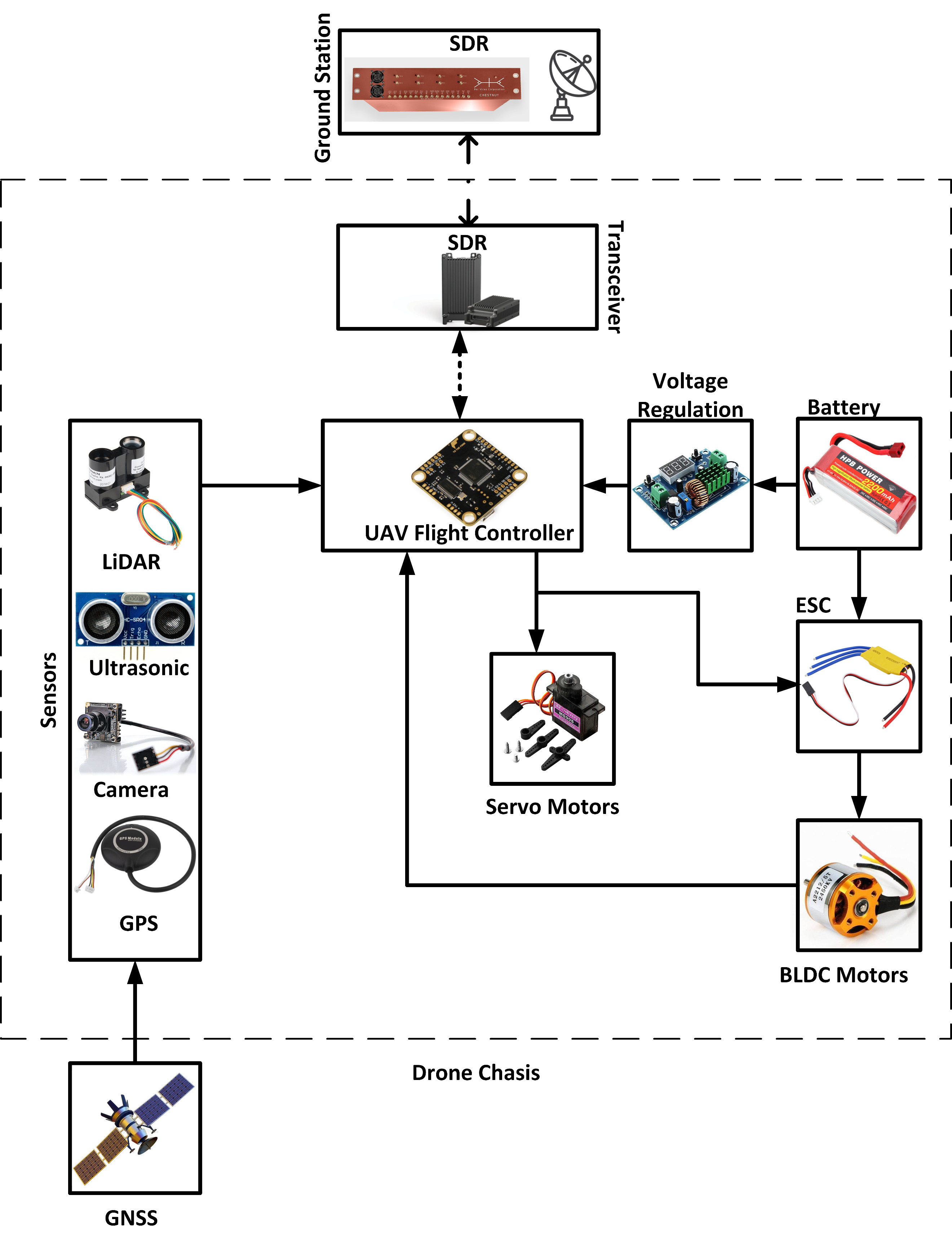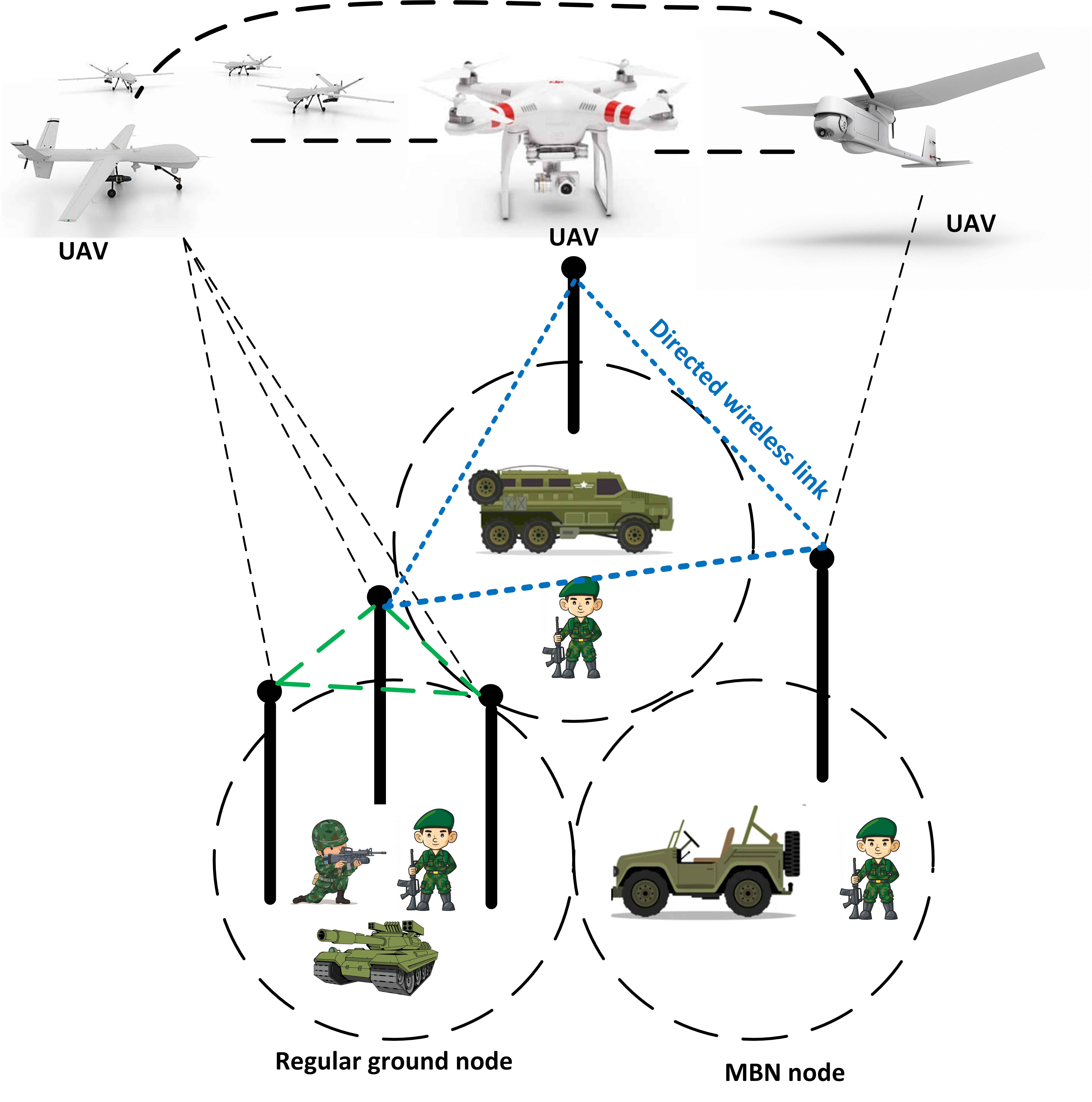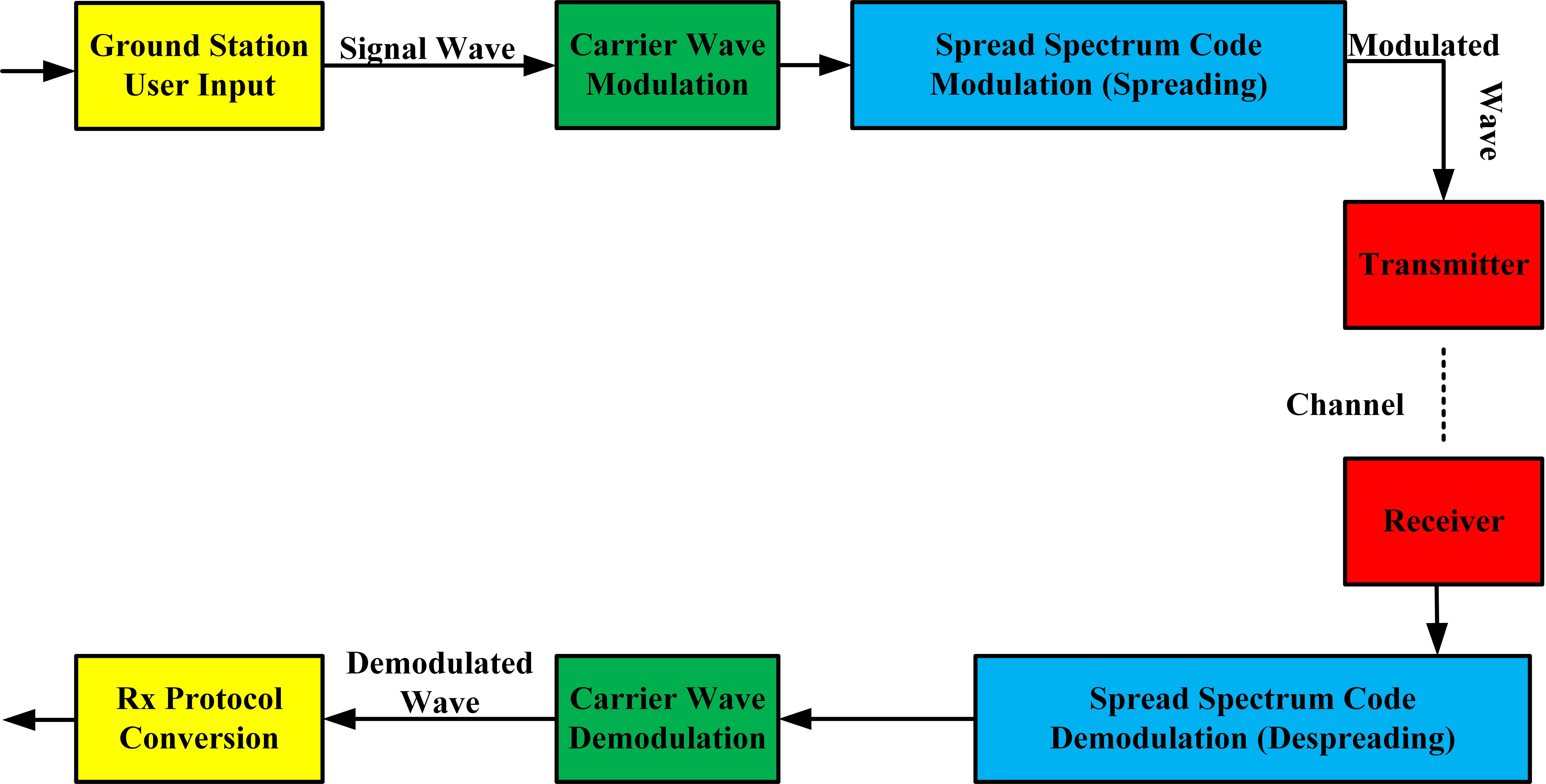SDRs For Controlling UAVs
By Brendon McHugh, Field Application Engineer and Technical Writer, Per Vices Corporation, and Abdullah Mughees, PhD student in Electrical Engineering
Researchers working on unmanned aerial vehicles (UAVs) are nowadays witnessing the exponential growth of their applications in the military domain. Security, expeditious maneuverability, complex autonomous control, reduced risk of human life, remote commands, and reduction in the decision time to strike are some of the key features that enable researchers to keep developing innovative technologies for the military [1]. UAVs used in defense often consist of two segments: the ground segment (control center) and the aerial segment (UAV itself). Both segments require the use of high-performance software-defined radios (SDRs) of different form factors, size, weight, and power (SWaP) in order to carry out critical missions. SDR is a highly flexible communication system that is capable of configuring the hardware to perform various functions.
In this article, we will discuss how SDRs fit into both of these segments by focusing on the command and control (C2) that the RF communications provide, such as collecting sensor, video, and image data for reconnaissance or even carrying out tactical missions such as drone strikes. We will also discuss the types of modulation/demodulation schemes needed to carry out near-real-time situational awareness for troops on the battlefield, as well as the types of computing/processing resources required. Furthermore, the importance of drones in performing various activities for soldiers on the battlefield (i.e., from clearing land mines to identifying RF emitters) is highlighted.
UAVs Overview
UAVs are airborne vehicles with no onboard passengers, crew, or pilots. For the air segment, the UAVs come in various shapes and sizes: from the smallest drone (Piccolissimo), weighing less than 2.5 grams with a 24.26 mm diameter, to a nano-copter style, to drones that are similar in size to a single-seater glider, to the largest ones, such as the Northrop Grumman RQ-4 Global Hawk, equivalent to a light business jet [2,3,4]. UAVs are typically piloted using the onboard computers that receive the control commands from a remote ground station. It is common for these ground control systems to allow the pilot to operate the craft and send live video and data to the outside world [5]. The C2 posts are setup for the ground segment and can range in size and sophistication, from a large-scale and fixed remote facility on a military base to temporary posts on the battlefield. For long-range operations, controllers in centralized locations handle the majority of mission tasks via satellite links. However, UAV pilots usually handle the takeoff and landing when their aircraft is within visual range. Similarly, for short-range operations or those needed during combat, it’s usually feasible to have a mobile C2 station setup to control/acquire data and information using the UAV on the battlefield. Various components involved in a UAV and ground station are shown in Figure 1.

Land-based control and communication systems for the UAVs are installed in the ground stations for exchanging information between the crew and a UAV. Hence, all of the remote communication captured by the UAV must be relayed to the C2 post. A vast amount of data (i.e., video, images, radar, telemetry data, etc.), sometimes streamed at sporadic intervals, is transmitted by the UAV. This data must often be processed in real-time to accomplish critical tasks.
The most commonly used term for UAVs is "drone," which is a remotely or autonomously piloted aircraft or ship [6]. Autonomous flight requires robust adaptive controllers to precisely navigate through complex scenarios. Typically, drones are often required to use GPS/GNSS signals for navigation. In the absence of a GPS signal, an inertial measurement unit (IMU) is required. Different UAVs require different control strategies due to their peculiar configurations. However, Skynav is a handheld controller developed by the Auterion Government Solutions (AGS) that provides control laws for multiple types of aerial robotic platforms [7]. Nonlinear, robust, and adaptive control laws require instantaneous input data through various sensors, making remote communication one of the most significant parts of the system. Drone communication maintains connections between drones and a ground station with an adequate data rate for fortifying real-time transmissions [8]. It can be classified into four main types: Drone-to-Drone (D2D), Drone-to-Ground Station (D2GS), Drone-to-Network (D2N), and Drone-to-Satellite (D2S). These types of communications often need to be highly secure (i.e., encrypted), which can be done via the Secure Common data link (CDL) Intelligence Surveillance Reconnaissance (SCISR).
Since these vehicles are unmanned, they are capable of quickly reaching the most remote areas that are in hazardous environments with no manpower. Hence, applications in the military domain have become their primary goal, with a predicted global market size reaching up to $23.78 billion by 2027 [9]. They can perform tactical missions like surveillance for situation awareness, protection, reconnaissance, target acquisition, or damage assessment with the least control effort and minimum energy. Also, they can incorporate weapons systems into the payload for "drone strikes." Strategic missions like target hitting and acquisition, reconnaissance, intelligence gathering, grasping, launching, complex maneuvers, and surveillance (ISR) missions, etc., in any weather conditions, can be accomplished in no time. This technology is even playing a key role in clearing minefields globally, saving countless human lives. Hundreds of years are required to demine the approximate 110 million active landmines scattered all around the globe. However, an EU-funded MKD project has the potential to clear landmines around the world in less than 10 years using the drones [10]. UAVs must be equipped with Synthetic-Aperture Radar systems (SAR) or Moving Target Indicators (MTI), infrared or thermal sensors, visible images, sound and video, remote control for maneuvering, etc., to have all these strategic and tactical capabilities. The acquired data from the onboard equipment must be relayed back to the ground station segment over RF signals and communication protocol schemes.
All the ground stations and UAVs are part of a Mobile Ad hoc Network (MANET) and a Flying Ad hoc Network (FANET). MANETs are often used to provide communication links between groups of people in an area where cellular communication is not available. It is a wireless network consisting of autonomous mobile nodes (PDAs, iPads, laptops, smartphones, etc.) that have no infrastructure and can control and distribute coordination [11]. The nodes are mobile and can organize themselves into a network. MANETs are extensively used in military applications where radio links lack fixed infrastructure or line-of-sight (LOS) communication since, without any fixed infrastructure, they can provide ubiquitous service access, anytime, anywhere. These are extremely useful in scenarios where restoring communication links is essential (i.e., when natural disasters disintegrate an entire communication infrastructure). These wireless networks can auto-connect and self-organize into decentralized systems. Hence, MANET will play a significant role in the next generation of computing, such as for the Internet of Things (IoT). A tactical MANET network for UAVs is shown in Figure 2.

SDRs for UAVs and Ground Stations
UAV's operational flight requires all of their various components to harmoniously perform their specific assigned task. One of the most important components among them is the communication system. UAV communication systems typically operate in the frequency range of 900 MHz to 5.8 GHz. The weight-carrying capacity and space for a communication system in a UAV are limited. To meet these constraints, the communication system must have reconfigurable functionalities to offer multifunctional capabilities with high accuracy at a lower price, which can be addressed by software-defined radio (SDR).
In SDR, the implementation of the components typically deployed in hardware (e.g., sensors, modulators, demodulators, filters, mixers, etc.) is instead embedded in software. Small, low-powered, and lightweight SDRs are integrated into a UAV for all radio-based control (maneuvering, perching, hovering, etc.) and data capturing. SDRs are controlled by radio frequency signals that are modulated/demodulated and are often based on spread spectrum techniques. The SDRs installed on the UAVs do not require high throughput capabilities like those found in FPGA-based SDRs. Many SDRs that communicate and are powered via USB 3.0 are suitable for UAVs. USB 3.0 is supplied by using mini-PCs that are also lightweight, small-sized, and have a low power demand. Alternatively, some SDRs come with an ARM processor embedded, allowing for standalone operation. The selected SDR must be able to encode, modulate, and transmit information to the C2 ground segment, along with receiving various radio signals to perform various tasks.
We have seen that SDRs installed on the UAVs must be lightweight, small-sized, and have a low power demand. However, SDRs used in C2 posts are much bigger and consume lots of power. To collect, store, process, and relay vast amounts of data, they have multi-input, multi-output (MIMO), and multi-frequency with embedded FPGA/SoC for conducting various UAV operations. MIMO SDR in ground segment C2 is expected to be able to connect to multiple other SDRs over the air. Therefore, the highest throughput SDRs must have a high sample rate and MIMO capabilities to ensure seamless communication. These SDRs may also have larger FPGAs that are useful for packetizing RF data over high-throughput Ethernet, which then offloads computationally intensive processing.
Basic modulation techniques like amplitude, frequency, and digital modulation are vulnerable to jamming and tempering since they can be demodulated to get the original message. Hence, SDRs in UAVs and ground stations use spread spectrum modulation, where the particular bandwidth of a signal is deliberately spread to yield a wider bandwidth signal. There are various techniques in spread spectrum modulation, such as Direct Sequence Spread Spectrum (DSSS), Frequency Hopping Spread Spectrum (FHSS), Time Hopping Spread Spectrum (THSS), and Chirp Spread Spectrum (CSS). These techniques are widely used since modulation of the original message signal on a fixed carrier wave makes the resultant signal wave vulnerable to tampering and jamming. Hence, the higher bandwidth achieved by the transmitted signal in the spread spectrum gives it resistance against interference. The ratio of the bandwidth of the modulated signal to that of the original data signal is referred to as the Processing Gain (Gp) of the system. This gives a quantifiable measure of the system’s resistance to interference. The block diagram of the spread spectrum scheme is shown in Figure 3.

Military radar and communication applications traditionally use commercial-off-the-shelf (COTS) SDR products due to their design flexibility and performance. The SOL8SDR2x1W-P is an SDR used in UAV military applications that enables encrypted links for the transfer of data, audio, video, and general IP network traffic in real-time at high speeds over long distances [12]. Similarly, SOLO8 Concealment is a single unit that can provide MIMO operations and IP meshing with high security [13]. RT-2071 (C) SCISR is another SDR with the latest and most secure transceiver technology [14]. In SDRs, smart components, end-to-end cyber security, encryption, and communication immunity are being used to ensure secure data exchange [15].
Risks, Challenges, And Mitigation Of UAVs In Adversary Territory
Despite the remarkable benefits of UAVs, there are substantial risks involved during their operation. In the worst-case scenario, adversaries jamming the signals for UAV communication may result in a crash landing or damage to the state. UAVs and drones can enter restricted areas (i.e., military bases and airports, government buildings, etc.) without being detected, which may be a cause for security concern. For example, a Russian drone caused $1 billion worth of damage to the Ukrainian military base a few years ago [16]. Furthermore, system limitations like signal and processing latency of real-time data may result in mission failure.
SDRs can provide mitigation strategies to the involved risks. SDRs with onboard FPGAs can do extremely fast parallelizable processing and thus decrease latency in networks requiring real-time data processing. Furthermore, as mentioned earlier, spread spectrum techniques in the SDRs can prevent detection, increase resistance to jamming, and reduce the external interference to minimum [17]. Even mitigating the effects of non-line-of-sight communications is possible. For instance, at the 2017 DARPA Bay Area Software Defined Radio (SDR) Hackfest, a UAV was used to enable the communication between another UAV and the ground station with a blocked or obstructed communication pathway [18].
Conclusion
This article focused on how SDRs fit into each of the two segments by gathering sensor, video, and image data for reconnaissance or even carrying out tactical and strategic operations. A few military-grade SDR COTS products are emphasized. Risks involved in the UAV systems are discussed, and the importance of SDRs using the spread spectrum to enable a secure and reliable communication link between the UAV and ground segment is highlighted.
Author Bio
Brendon McHugh is a Field Application Engineer and Technical Writer at Per Vices Corporation, and possesses a degree in Theoretical and Mathematical Physics from the University of Toronto. Abdullah Mughees is a PhD student in Electrical Engineering with a focus on UAVs. Per Vices has extensive experience in developing and integrating highly secure SDRs for mission-critical defense applications, including UAV/drone communication and control. Brendon can be reached at solutions@pervices.com.
References
- https://reliefweb.int/sites/reliefweb.int/files/resources/Study%20on%20Armed%20Unmanned%20Aerial%20Vehicles.pdf
- https://futurism.com/this-quarter-sized-self-powered-drone-is-the-smallest-in-the-world#:~:text=The%20Piccolissimo%20is%20the%20world's,39%20inches).
- Piccoli, Matthew, and Mark Yim. "Piccolissimo: The smallest micro aerial vehicle." In 2017 IEEE International Conference on Robotics and Automation (ICRA), pp. 3328-3333. IEEE, 2017.
- Petrescu, Relly Victoria, Raffaella Aversa, Bilal Akash, Juan Corchado, Filippo Berto, Antonio Apicella, and Florian Ion Petrescu. "About northrop grumman." Journal of Aircraft and Spacecraft Technology 1, no. 3 (2017).
- https://www.extendingbroadband.com/aerial-tracking/ground-stations-uavs/#:~:text=Ground%20stations%20for%20UAVs%2C%20or,streaming%20live%20video%20and%20data.
- https://www.identifiedtech.com/blog/uav-surveying/drone-technology-ending-the-drone-vs-uav-debate-drone-basics-101/#:~:text=A%20drone%20is%20an%20unmanned,fly%20without%20a%20pilot%20onboard.
- https://www.thedefensepost.com/2021/11/30/us-remote-multiple-drones/
- Sharma, Vishal. "Advances in drone communications, state-of-the-art and architectures." Drones 3, no. 1 (2019): 21.
- https://www.businessinsider.com/drone-technology-uses-applications
- https://cordis.europa.eu/article/id/422614-clearing-landmines-with-the-help-of-drones
- https://idstch.com/military/air/militaries-employing-airborne-mobile-ad-hoc-network-manet-radios-critical-technology-uavs-swarms-networked-battlefield-environment/
- https://www.militaryaerospace.com/communications/article/14211036/softwaredefined-radio-unmanned-mobile-adhoc-network-manet
- https://www.unmannedsystemstechnology.com/expo/software-defined-radio/
- https://www.collinsaerospace.com/what-we-do/Military-And-Defense/Communications/Tactical-Data-Links/RT-2071C-Secure-CDL-ISR-SCISR-Radio
- https://www.unmannedsystemstechnology.com/company/mobilicom/
- https://www.youtube.com/watch?v=p7DfyW7_4CU&list=PLlJ3C2PHtJczk9yy9HAE6V5aapsKsfFVe
- Pärlin, Karel & Alam, Muhammad & Le Moullec, Yannick. (2018). Jamming of UAV Remote Control Systems Using Software Defined Radio. 10.1109/ICMCIS.2018.8398711.
- https://www.darpa.mil/news-events/2017-12-14
